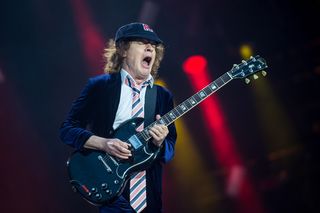
For these reasons, Angus always preferred the JTM50. There are many places online that will claim Angus used a JTM45 for those records, but that is wrong – JTM45s differ sonically from JTM50s in that they are not as tight and responsive as their solid-state counterparts and their bass response is quite undefined, saturation levels are also different on the JTM50 compared to the JTM45. The JTM50 was an often-forgotten transitional amp between the JTM45 and the Plexi JMPs. On Highway To Hell and Back in Black, Angus used a combination of his favourite amp, a 1970s four-input 100-watt 1959 Super Lead, along with another amp that many have mistaken for a JTM45, but it was actually the very rare Marshall JTM50 (made between 19). Uncertainty breeds mythology, and along the way plenty of incorrect information has passed into common understanding – but never fear, we’re here to correct some of these inaccuracies, and give you a clearer picture of what Angus’s guitar tone is really made of. READ MORE: Eight myths about Kurt Cobain’s gear that people still believeĪngus has never been fond of talking about his gear or tone that much on record, and into that void has been poured a great deal of speculation and conjecture about how exactly the SG’s most famous exponent really gets those iconic guitar sound. Angus Young might be small in stature, but his tone is stratospheric, and set the template for countless other bands, while establishing himself as one of true guitar icons of classic rock. There is perhaps no band more reflective of the pure unadulterated sound of rock ‘n’ roll. Young is one of those guitarists that show us that you can get an excellent tone with nothing more than a guitar, a cable, and an amp.Five myths about Angus Young’s AC/DC guitar gear that people still believe

When it comes to getting a classic rock sound like that of Angus Young, a ‘less is more’ approach is the way to go. It’s a bit on the expensive side, but it’s an almost exact replica of the Schaffer-Vega pedal that was used by Young live and in the studio for most of his career.


It’s a great boost/drive combo pedal, so you only need the one pedal. If you want to go with a pedal, I would recommend a high quality one like the TC Electronics Zeus. Young’s PedalsĪngus Young isn’t really known for his pedal setup, preferring a more direct guitar and amp rig.īut you might not have an amp with an overdrive channel, or you want to use a pedal instead of your amps overdrive channel. Even if you have the exact same gear, no two amps or guitars are the same, and you might still need to do some fine tuning to get it to sound just right. If you want a brighter sound, for songs with more open chords like ‘You Shook Me All Night Long’, try turning up the treble and dialing back the mids a bit.Īs always, getting the tone exact might need some tweaking since everyone’s setup is different. These settings should work fine for heavier songs like ‘Rock or Bust’. But everything else is kept at about half.ĪC/DC is a loud band though, so crank your amps volume as high as you can before it starts clipping or starts hurting to listen to. You might just need to adjust the mids a bit higher to round out the sound a little more. His tone is actually fairly standard, and if you dial in a traditional classic rock tone, you’ll be good to go. Young’s guitar tone isn’t particularly heavy or distorted, so you don’t need a lot of gain or low end. Now that you have the right guitar and amp, it’s time to start dialing in the right amp settings to get that classic AC/DC guitar tone. If you want to go for a bit more of a vintage sound, then something like the Marshall SV112 would be the one to go with. It’s a reissue of the old ‘60s JTM45, making it perfect for recreating an old school rock sound like that of Angus Young.įor the cabinet, a go-to for nearly any Marshall amp head would be the Marshall 1960A, a solid all-round extension cab. Young originally used the Marshall 2203 JMP, but a great modern alternative is the JTM45.

When it comes to amps, the only way to really go is with a Marshall. Something like the Gibson Custom 1961 Reissue or the Custom 1963 Special Reissue, in cherry red of course.Ī Gibson SG Standard is also a great option, and if you’re on a budget, you can even go down to an Epiphone SG Standard ‘61 or SG Special. To be as true to Young’s SG of choice, a ‘60s Custom is the way to go. Specifically, the Gibson SG’s with their iconic ‘horns’ on either side of the guitars neck. Angus Young does play Fender guitars from time to time, but he is best known for playing Gibsons.


 0 kommentar(er)
0 kommentar(er)
